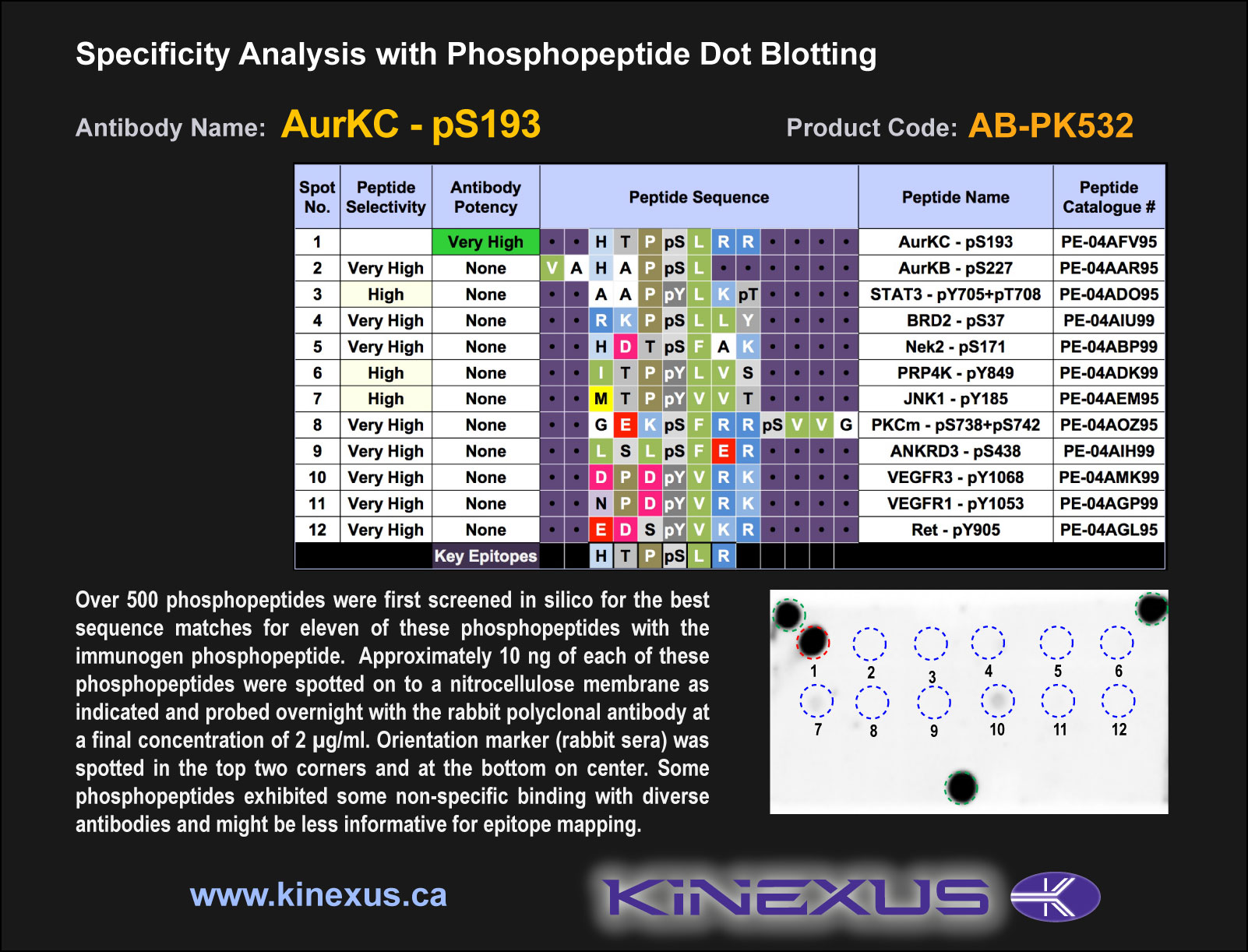Product Name: AurKC-pS193
Product Number: AB-PK532
| Size: | 25 µg | Price: | 89.00 | |
| $US |
Target Full Name: Aurora Kinase C (serine/threonine-protein kinase 13)
Target Alias: AIE1; AIE2; AIK3; AurkC; Aurora,Ipl1,Eg2 protein 1 and 2; Aurora,Ipl1-related kinase 3; Aurora-C; STK13; STKD
Product Type Specific: Protein kinase phosphosite-specific antibody
Antibody Code: PK532
Antibody Target Type: Phosphosite-specific
Antibody Phosphosite: S193
Protein UniProt: Q9UQB9
Protein SigNET: Q9UQB9
Antibody Type: Polyclonal
Antibody Host Species: Rabbit
Target Alias: AIE1; AIE2; AIK3; AurkC; Aurora,Ipl1,Eg2 protein 1 and 2; Aurora,Ipl1-related kinase 3; Aurora-C; STK13; STKD
Product Type Specific: Protein kinase phosphosite-specific antibody
Antibody Code: PK532
Antibody Target Type: Phosphosite-specific
Antibody Phosphosite: S193
Protein UniProt: Q9UQB9
Protein SigNET: Q9UQB9
Antibody Type: Polyclonal
Antibody Host Species: Rabbit
Antibody Immunogen Source: Human AurKC (Aurora C, AIK3) sequence peptide Cat. No.: PE-04AFV95
Antibody Immunogen Sequence: HTP(pS)LRR(bA)C
Antibody Immunogen Description: Corresponds to amino acid residues H190 to R196; In the protein kinase catalytic domain activation T loop region between subdomains VII and VIII.
Antibody Immunogen Sequence: HTP(pS)LRR(bA)C
Antibody Immunogen Description: Corresponds to amino acid residues H190 to R196; In the protein kinase catalytic domain activation T loop region between subdomains VII and VIII.
Production Method: The immunizing peptide was produced by solid phase synthesis on a multipep peptide synthesizer and purified by reverse-phase hplc chromatography. Purity was assessed by analytical hplc and the amino acid sequence confirmed by mass spectrometry analysis. This peptide was coupled to KLH prior to immunization into rabbits. New Zealand White rabbits were subcutaneously injected with KLH-coupled immunizing peptide every 4 weeks for 4 months. The sera from these animals was applied onto an agarose column to which the immunogen peptide was thio-linked. Antibody was eluted from the column with 0.1 M glycine, pH 2.5. Subsequently, the antibody solution was neutralized to pH 7.0 with saturated Tris.This antibody was also subject to negative purification over phosphotyrosine-agarose.
Antibody Modification: Unconjugated. Contact KInexus if you are interest in having the antibody biotinylated or coupled with fluorescent dyes.
Antibody Modification: Unconjugated. Contact KInexus if you are interest in having the antibody biotinylated or coupled with fluorescent dyes.
Antibody Concentration: 1 mg/ml
Storage Buffer: Phosphate buffered saline pH 7.4, 0.05% Thimerasol
Storage Conditions: For long term storage, keep frozen at -40°C or lower. Stock solution can be kept at +4°C for more than 3 months. Avoid repeated freeze-thaw cycles.
Product Use: Western blotting | Antibody microarray
Antibody Dilution Recommended: 2 µg/ml for immunoblotting
Antibody Potency: Very strong immunoreactivity with immunogen peptide on dot blots.
Antibody Species Reactivity: Human
Antibody Positive Control: The observed molecular mass of the processed target protein on SDS-PAGE gels is reported to be around 35-40 kDa.
Storage Buffer: Phosphate buffered saline pH 7.4, 0.05% Thimerasol
Storage Conditions: For long term storage, keep frozen at -40°C or lower. Stock solution can be kept at +4°C for more than 3 months. Avoid repeated freeze-thaw cycles.
Product Use: Western blotting | Antibody microarray
Antibody Dilution Recommended: 2 µg/ml for immunoblotting
Antibody Potency: Very strong immunoreactivity with immunogen peptide on dot blots.
Antibody Species Reactivity: Human
Antibody Positive Control: The observed molecular mass of the processed target protein on SDS-PAGE gels is reported to be around 35-40 kDa.
Antibody Specificity: Very high
Antibody Cross Reactivity: No immunoreactivity on protein dot blots with recombinant human AurKA and AurKB. No significant cross-reactive proteins detected in A431, HeLa, and TG98 cells and sea star oocytes, except a strong 78 kDa protein in A431 cells.
Related Product 1: AurKC-pS193 blocking peptide
Related Product 2: AurKC-1 pan-specific antibody (Cat. No.: AB-NK009-2)
Related Product 3: AurKC-2 pan-specific antibody (Cat. No.: AB-NK009-3)
Antibody Cross Reactivity: No immunoreactivity on protein dot blots with recombinant human AurKA and AurKB. No significant cross-reactive proteins detected in A431, HeLa, and TG98 cells and sea star oocytes, except a strong 78 kDa protein in A431 cells.
Related Product 1: AurKC-pS193 blocking peptide
Related Product 2: AurKC-1 pan-specific antibody (Cat. No.: AB-NK009-2)
Related Product 3: AurKC-2 pan-specific antibody (Cat. No.: AB-NK009-3)
Scientific Background: AurC (AurKC) is a protein-serine/threonine kinase of the Other group and AUR family. It serves an essential component of the chromosomal passenger complex (CPC), which functions to ensure correct chromosomal alignment and segregation during mitosis. In addition, this protein complex is necessary for chromatin-induced microtubule stabilization and formation of the spindle apparatus. AurC has also been shown to play a key role in meiosis, specifically during spermatogenesis (production of sperm). Several mutations in the AurC gene have been observed in male patients with spermatogenic failure 5, including a 1-bp deletion (144delC) leading to premature translation termination at position 71 and a truncated protein without a catalytic domain, a C229Y substitution mutation in the kinase catalytic domain of the protein, and a 2A-to-G transition mutation at the splice site of intron 4 (436-2A-G) leading to the omission of exon 5 from the protein. These mutations result in a loss-of-function for the protein catalytic activity, therefore defects in AurC activity are thought to be the primary contributing factor to the development of spermatogenic failure 5.
Figure 1. Epitope mapping of AurKC-pS193 antibody with similar phosphopeptides on dot blots.
Figure 2. Identification of phosphosites related to AurKC-pS193.
© Kinexus Bioinformatics Corporation 2017



